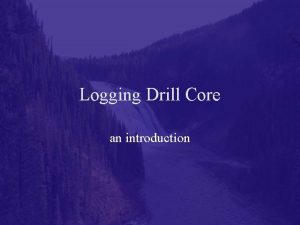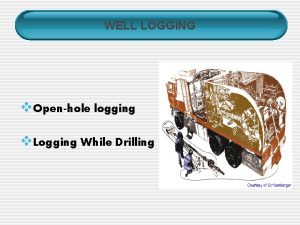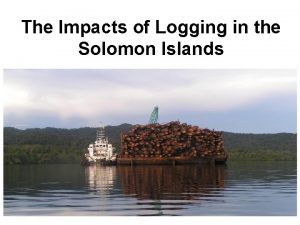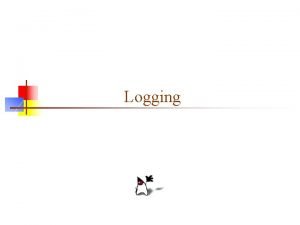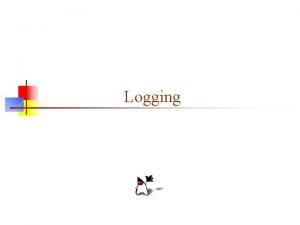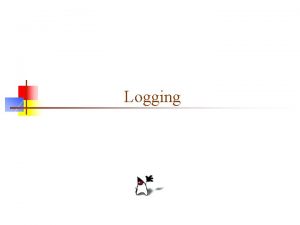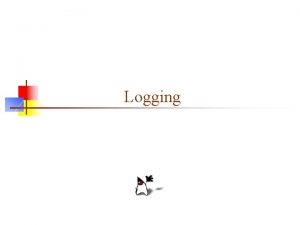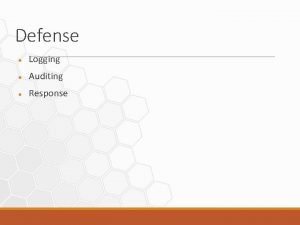Logging Drill Core an introduction Why is drill















- Slides: 15

Logging Drill Core an introduction

Why is drill core cut? • Drill core offers the most complete sampling of rock encountered in the subsurface • Geophysical logs are gathered under less than ideal conditions, yield an incomplete picture, and are subject of a fair bit of guesswork • Drill cuttings (chips) yield insight into mineralogy/lithology/texture, but none on structures, offer poor vertical resolution, and are too small to be used for assessing reservoir properties • Sidewall core allows for some reservoir data, but yields an incomplete picture of the rock structure, with little sed-strat applicability

Why not core everything? • Unlike in hard-rock exploration, geophysical tools do a reasonably good job assessing rock character, lithological variation is more constrained, and core samples cannot be retrieved without “tripping” the drill -string • This adds up to time, money and declining returns • The combination of core and logs allows for data to be extrapolated laterally to other locations once the logs have been ground truthed

Logging core • A job that most every petroleum geologist is required to do on occasion, but few (aside from academics, consultants and oil sands geologists) do with regularity or in great detail • Usually done to solve problems not readily dealt with using more “office-friendly” data, or when looking at the rock with an eye towards reservoir characterization • There are private labs, and government labs • The EUB lab in Calgary is the behemoth

Getting started • Make sure you have what you want for core, and in proper order • Core orientation • Key the core to the wireline logs, and measure it out (depths on the boxes aren’t generally accurate) • Clean the core if it is dirty • Assess the core and break it down into broad zones or intervals of consistent character • Describe the rock, guided by this break-down, taking what detail is prudent for the task at hand • Usually this involves generating a detailed lithological column

Additional stuff • Detailed photographs of representative material, and anomalous/insightful features • “Box shots” of the full core to give context when returning to the litholog and detail photos • Gather any samples needed

Carbonate Reservoirs - More than 60% of the world’s oil and 40% of the world’s gas reserves are held in carbonates. - The Middle East has 62% of the world’s “proved” conventional oil reserves; approximately 70% of these reserves are in carbonate reservoirs. - The Middle East also has 40% of the world’s “proved” gas reserves; 90% of these gas reserves lie in carbonate reservoirs. - Therefore, due to the complex internal nature of carbonate rocks, proper understanding of the core is required before any additional work is completed.

Porosity The porosity of carbonates can be grouped into three types: a) Connected porosity- exists between the carbonate grains. b) Vugs- they are unconnected pores resulting from the dissolution of calcite by water during diagenesis. c) Fracture porosity- caused by stresses following deposition. These can also cause styolites, which can form horizontal flow barriers, and can sometimes extend over kilometers within the rock.

Fabric selective Porosity a) Interparticle Porosity: between particles b) Intraparticle Porosity: within individual particles or grains c) Intercrystal Porosity: between crystals d) Moldic Porosity: type of secondary porosity created through the dissolution of a preexisting constituent of a rock, such as a shell, rock fragment or grain. The pore space preserves the shape, or mold, of the dissolved material. e) Fenestral Pores larger than grain-supported interstices (interparticle) ** If the rock becomes a dolomite, they will often be of higher porosity, presenting as a friable, “sugary” texture. This is because dolomitization causes 13% shrinkage of the original bulk volume, therefore increasing the overall porosity- this is known as “sucrosic porosity” Non fabric selective a) Fracture: Porosity formed by fracturing b) Channel: Markedly elongate pores c) vug: Pores larger than 1/16 mm in diameter and somewhat equant inshape d) Cavern: very large channel or vug

Carbonate Terminology • Dolomitic: has the mineral dolomite in it (no we do not have dolomitic dolostone!!) • Calcareous: has the mineral calcite in it (do not use with limestone) • Argillaceous: has clay present in it. • Arenaceous: has sand size detrital grains • Fossiliferous: dead plants and animals • Oolitic: oolites present (but you have to be certain of this; use your hand lens) • Pisolitic: contains pisolites • Cherty: chert nodules present • Brecciated: the rock is broken in situ

Mudstone: the rock is as you see it mostly made of carbonate mud or cryptocrystalline carbonate matrix. Grains (fossils, ooids, etc. ) will be less than 10 % of the rock. Wackestone: grains make up more than 10% of the rock but the grains are "mud supported" they float in the mud matrix. Packstone: Lots of sandbox sized grains with mud between them but the grains are grain supported. Grainstone: Sandbox sized grains with spar between them, little or no mud. Boundstone: "Original components organically bound during deposition" think of colonial corals and stromatolites

Defining Crystal Size • Aphanocrystalline: Under 0. 0039 mm • Very finely crystalline: 0. 0039 to 0. 0156 mm • Finely crystalline: 0. 0156 to 0. 0625 mm • Medium crystalline: 0. 0625 to 0. 25 mm • Coarsely crystalline: 0. 25 to 1. 00 mm • Very coarsely crystalline: 1. 00 to 4. 00 mm • Extremely coarsely crystalline: Over 4. 00 mm

When Logging the Core • When written descriptions are required, a standardized order of description: (1) reduces the chance of not recording all important properties, (2) increases the uniformity of description among geologists, and (3), saves time in obtaining specific information from descriptions. 1. Color- note mottling, variegation. Common colors are: brown, tan, buff, cream, pink, white, rust, brick red, grey, etc. 2. Texture- Crystalline (give size): sucrosic or granular: oolitic pseudo-oolitic, pelletoid: fossil fragmental microbreccia: matte, dense, extra fine x-line: chalky, earthy: vuggy, microvuggy (note if filled) 3. Cementing- co-deposited, or disseminated material - limy, dolomitic, cherty or siliceous, silty, sandy anhydritic, gypsiferous, saliferous, argillaceous, floating quartz, druse quartz. 4. Accessories- glauconite, chlorite, iron oxides, phosphate, bitumen. 5. Structures- brecciation, fracturing, stylolites, laminae. 6. Common associates- anhydrite, salt, chert, shale. 7. Dunham Classification 8. Porosity, oil staining

Graphic core logs

 Drill core logging
Drill core logging Why why why why
Why why why why Dont ask
Dont ask Inner core and outer core
Inner core and outer core Crust mantle core
Crust mantle core What are the 3 main layers of the earth? *
What are the 3 main layers of the earth? * Core rigidities
Core rigidities Openhole logging
Openhole logging Negative effects of logging in solomon islands
Negative effects of logging in solomon islands Oracle check supplemental logging enabled
Oracle check supplemental logging enabled Perl logger
Perl logger Wireline logging operation
Wireline logging operation Electronic logging device definition
Electronic logging device definition Advantages of data logging
Advantages of data logging Eld rule summary
Eld rule summary Mono logging
Mono logging
